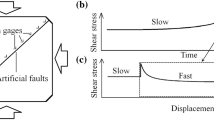Abstract
Stability of undrained shearing in a classical Cauchy continuum has been first analyzed by Rice (J Geophys Res 80(11):1531–1536, 1975) who showed that instability occurs when the underlying drained deformation becomes unstable (i.e. in the softening regime of the corresponding drained stress-strain curve). However Vardoulakis (Int J Numer Anal Methods Geomech 9:339–414, 1985; Int J Numer Anal Methods Geomech 10:177–190, 1986) has shown that Rice’s linear stability analysis, if performed at the state of maximum deviator, leads to a sharp transition from infinitely stable to infinitely unstable behaviour, which indicates that the solution of the considered initial-value problem does not exist and consequently that the corresponding problem is mathematically ill-posed. Vardoulakis (Géotechnique 46(3):441–456, 1996; Géotechnique 46(3):457–472, 1996) proposed a regularization of the ill-posed problem in the softening regime by resorting to a second grade extension of plasticity theory. In this paper, the kinetics of a granular material is described by a Cosserat continuum as first suggested by Mühlhaus and Vardoulakis (Géotechnique 37:271–283, 1987) and we incorporate the effect of shear heating due to the dissipation of the frictional work. The undrained adiabatic limit is applicable as soon as the slip event is sufficiently rapid and the shear zone broad enough to effectively preclude heat or fluid transfer as it is the case during an earthquake or a landslide. It is shown that shear heating has a destabilizing effect and that instability can occur in the hardening regime if the amount of dilatant strengthening is not sufficient as compared to the effect of thermal pressurization of the pore fluid. It is shown that the linear stability analysis with macro and micro inertia terms leads to the selection of a preferred wave length of the instability mode corresponding to the instability mode with fastest (but finite) growth coefficient.
Similar content being viewed by others
References
Rice J.R.: Heating and weakening of faults during earthquake slip. J. Geophys. Res. 111, B05311 (2006)
Vardoulakis I.: Dynamic thermo-poro-mechanical analysis of catastrophic landslides. Géotechnique 52(3), 157–171 (2002)
Veveakis E., Vardoulakis I., Di Toro G.: Thermoporomechanics of creeping landslides: The 1963 Vaiont slide, Northern Italy. J. Geophys. Res. 112, F03026 (2007)
Sulem J., Vardoulakis I., Ouffroukh H., Perdikatsis V.: Thermo-poro-mechanical properties of the Aigion fault clayey gouge—application to the analysis of shear heating and fluid pressurization. Soils Found. 45(2), 97–108 (2005)
Sulem J., Lazar P., Vardoulakis I.: Thermo-poro-mechanical properties of clayey gouge and application to rapid fault shearing. Int. J. Numer. Anal. Methods Geomech. 31, 523–540 (2007)
Brantut N., Schubnel A., Rouzaud J.-N., Brunet F., Shimamoto T.: High velocity frictional properties of a clay-bearing fault gouge and implications for earthquake mechanics. J. Geophys. Res. 113, B10401 (2008)
Brantut N., Schubnel A., Corvisier J., Sarout J.: Thermochemical pressurization of faults during coseismic slip. J. Geophys. Res. 115, B05314 (2010)
Sulem J., Famin V.: Thermal decomposition of carbonates in fault zones: slip-weakening and temperature-limiting effects. J. Geophys. Res. 114, B03309 (2009)
Veveakis E., Alevizos S., Vardoulakis I.: Chemical reaction capping of thermal instabilities during shear of frictional faults. J. Mech. Phys. Solids 58(9), 1175–1194 (2010)
Rice J.R.: On the stability of dilatant hardening for saturated rock masses. J. Geophys. Res. 80(11), 1531–1536 (1975)
Vardoulakis I.: Stability and bifurcation of undrained, plane rectilinear deformations on water-saturated granular soils. Int. J. Numer. Anal Methods Geomech. 9, 339–414 (1985)
Vardoulakis I.: Dynamic stability of undrained simple shear on water-saturated granular soils. Int. J. Numer. Anal. Methods Geomech. 10, 177–190 (1986)
Rudnicki J.W.: Effects of dilatant hardening on the development of concentrated shear deformation in fissured rock masses. J. Geophys. Res. 89(B11), 9259–9270 (1984)
Vardoulakis I.: Deformation of water-saturated sand: I. Uniform undrained deformation and shear banding. Géotechnique 46(3), 441–456 (1996)
Vardoulakis I.: Deformation of water-saturated sand: II. Effect of pore water flow and shear banding. Géotechnique 46(3), 457–472 (1996)
Mühlhaus H.-B., Vardoulakis I.: The thickness of shear bands in granular materials. Géotechnique 37, 271–283 (1987)
Vardoulakis I., Sulem J.: Bifurcation Analysis in Geomechanics. Chapman & Hall, London (1995)
Sulem J.: Bifurcation theory and localization phenomena. Eur. J. Civ. Environ. Eng. 14(8–9), 989–1009 (2010)
Author information
Authors and Affiliations
Corresponding author
Rights and permissions
About this article
Cite this article
Sulem, J., Stefanou, I. & Veveakis, E. Stability analysis of undrained adiabatic shearing of a rock layer with Cosserat microstructure. Granular Matter 13, 261–268 (2011). https://doi.org/10.1007/s10035-010-0244-1
Received:
Published:
Issue Date:
DOI: https://doi.org/10.1007/s10035-010-0244-1




